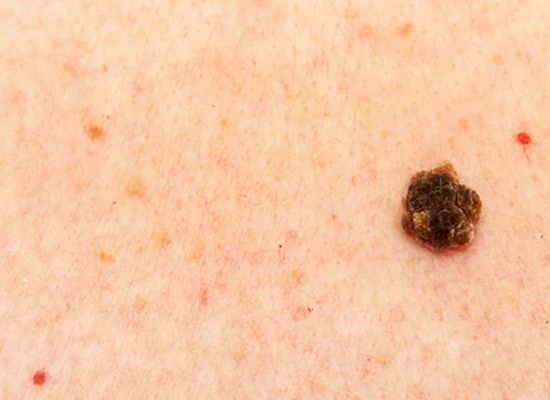
Seborrheic Keratosis (SK) is one of the most common non-cancerous skin growths seen in adults, particularly after the age of 40. These benign lesions appear when excess skin cells accumulate on the outer layer of skin, creating a flat or raised spot that can be white, tan, brown, black, or any combination thereof. While these growths are not dangerous or contagious, they can mimic skin cancer to the untrained eye and may cause concern due to their appearance or irritation. If you’re noticing new growths on your skin and wondering what they are, you’re not alone; SKs affect millions of people every year.
Understanding Seborrheic Keratoses
Seborrheic keratoses (SKs) can develop anywhere on the body except for the palms and soles. Some key facts about SKs include:
- They often appear in adulthood, with a sharp increase in prevalence after age 40
- By age 65, up to 90% of people have at least one SK
- These lesions tend to run in families, suggesting a genetic component
- Hormonal changes, such as pregnancy or hormone replacement therapy, may trigger their development
- SKs are not linked to sun exposure
While SKs are generally harmless, it’s important to have new or changing growths evaluated by a dermatologist to rule out skin cancer or other serious skin conditions.
What Does a Seborrheic Keratosis Look Like?
SKs vary widely in appearance and texture. Common characteristics include:
- Oval or round shape
- Warty, waxy, or velvety surface
- Colors ranging from white, light tan, to brown and/or black
- “Stuck-on” appearance, as if the growth is glued to the skin’s surface
- Can appear alone or in clusters
A specific condition known as dermatosis papulosa nigra (DPN) often affects people with darker skin tones and occurs when small, dark SKs grow in clusters on the face. Individuals with lighter skin tones are less commonly affected by this SK variation but tend to develop greater numbers of SKs overall.
Are Seborrheic Keratoses Dangerous?
No, seborrheic keratoses are not dangerous. They are not precancerous or cancerous and generally do not require treatment. However, they can be mistaken for melanoma or other types of skin cancer, so it’s important to have a dermatologist examine any suspicious lesions. Your dermatologist may perform a skin biopsy to confirm the diagnosis in uncertain cases.
SKs may become irritated, inflamed, itchy, or even bleed, especially if rubbed by clothing or scratched. In these cases, treatment to remove the lesion may be recommended for medical reasons. In other cases, removal may be done for cosmetic concerns if the growth is in a cosmetically sensitive area..
Treatment Options for Seborrheic Keratoses
There is no proven way to prevent SKs from forming, and new ones may appear over time. Fortunately, there are effective treatment options that can help remove them safely.
Keep in mind that cosmetic removal is not covered by insurance, but treatment of irritated or bleeding SKs may be considered medically necessary.
1. Cryotherapy (Freezing)
- The most common treatment method
- Uses liquid nitrogen to freeze and destroy the lesion
- May cause blistering, crusting, and pigment changes as the skin heals
- Multiple treatments may be required for thicker or larger SKs
- People with darker skin tones may experience permanent lightening (hypopigmentation) of the treated area
2. Shave Removal
- Uses a blade to shave off the SK after anesthetizing the site
- Often used for larger and thicker lesions
3. Electrodessication
- Involves using an electric current to melt and destroy the lesion
- Often combined with curettage to remove the treated tissue
- May take longer for larger lesions
- Often used for smaller lesions located in sensitive areas such as the eyelids
4. Curettage (Scraping)
- Uses a curette, a special rounded blade, to scrape off the lesion
- Commonly paired with electrodessication or freezing
- Typically used for thinner SKs
5. Topical Treatment
- Eskata: a newer option; involves a prescription 40% hydrogen peroxide solution applied in-office
- May require multiple sessions
- Approved by the FDA for use in SK treatment
Your dermatologist will determine which method is best depending on the size, location, and appearance of the SK, as well as your skin type.
When to See a Dermatologist
It’s a good idea to schedule an evaluation if:
- A new skin growth appears
- You notice changes in size, shape, or color of an existing growth
- A lesion becomes itchy, irritated, or starts to bleed
- You’re concerned about the cosmetic appearance of a growth
Even though SKs are benign, peace of mind and early intervention can go a long way in protecting your skin health.
Living with Seborrheic Keratoses
While seborrheic keratoses can be annoying or unsightly, they are not harmful to your health. Many people choose to live with them, while others prefer removal for comfort or aesthetic reasons. In either case, a board-certified dermatologist can help you decide on the best course of action.
If you’re unsure whether a spot on your skin is a harmless SK or something more serious, don’t wait. Schedule a consultation with our experienced dermatology team in Denver/Lakewood today. We’ll examine your skin, provide a diagnosis, and offer treatment options tailored to your needs. Whether your concern is medical or cosmetic, we’re here to help you feel confident in your skin.
